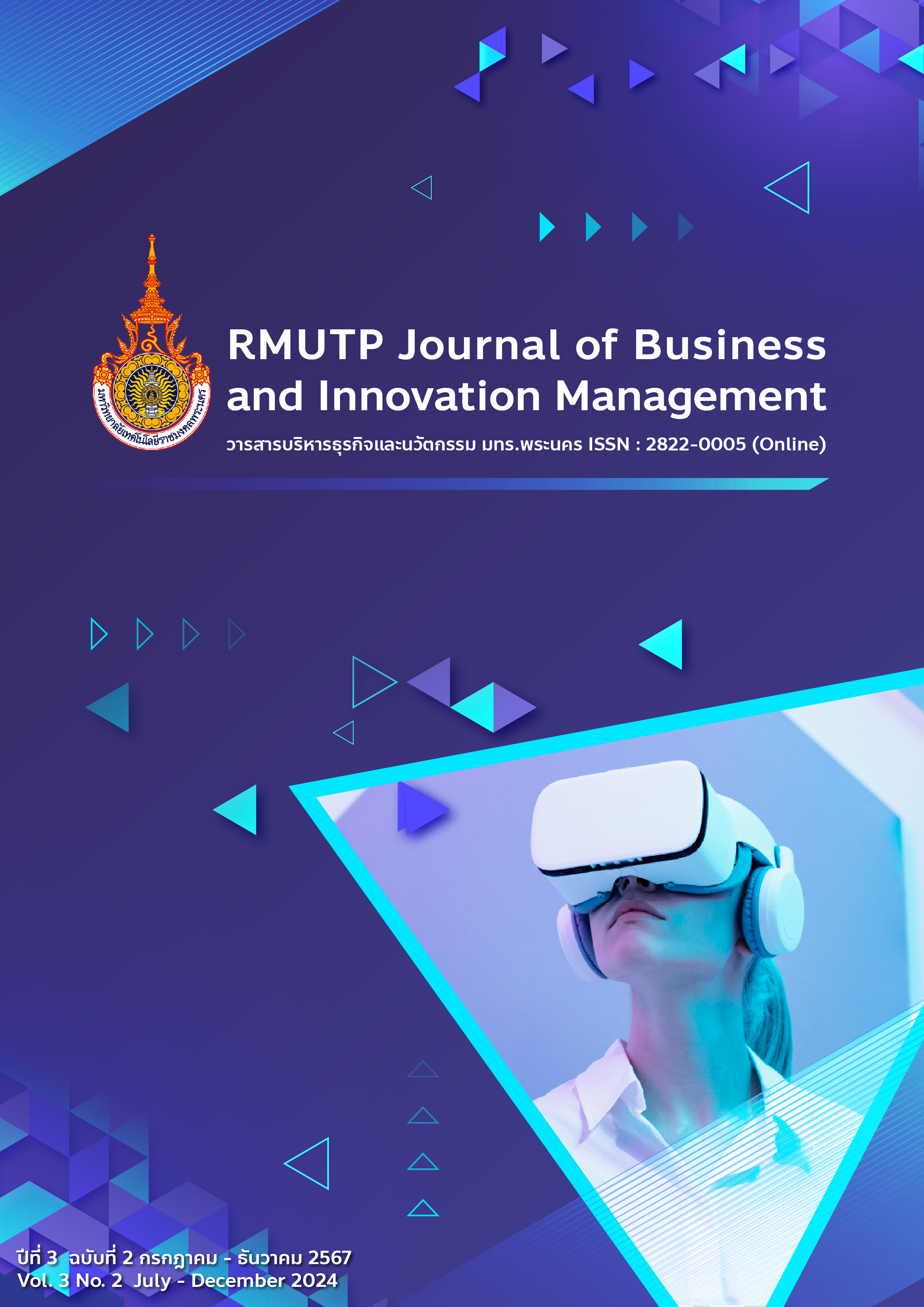ความสัมพันธ์ระหว่าง Altman Z-Score และความผันผวนของราคาหลักทรัพย์ ในช่วงการแพร่ระบาดโควิด-19
Main Article Content
บทคัดย่อ
งานวิจัยนี้ มีวัตถุประสงค์เพื่อศึกษาว่าแบบจำลอง Altman Z-Score ที่ได้รับการทดสอบว่า สามารถจำแนกบริษัทที่มีความเสี่ยงล้มละลายสูงและบริษัทที่มีความแข็งแกร่งทางการเงินได้ จะสามารถพยากรณ์ความผันผวนของราคาหลักทรัพย์ในช่วงการแพร่ระบาดโควิด-19 ได้หรือไม่ งานวิจัยนี้เลือกศึกษาเฉพาะธุรกิจบริการที่จดทะเบียนในตลาดหลักทรัพย์แห่งประเทศไทย เพราะเป็นธุรกิจที่ได้รับผลกระทบแง่ลบจากการแพร่ระบาดโควิด-19 กลุ่มตัวอย่างถูกแบ่งออกเป็นสองกลุ่ม คือกลุ่มความเสี่ยงล้มละลายสูงและกลุ่มความเสี่ยงล้มละลายต่ำ จากค่า Altman Z-Score หลังจากนั้นได้เปรียบเทียบความ
ผันผวนของราคาหลักทรัพย์ตลอดปี พ.ศ. 2563 ของทั้งสองกลุ่มด้วยวิธี Paired Sample T-test และการวิเคราะห์สมการถดถอย ผลวิจัยแสดงหลักฐานเชิงประจักษ์ว่า กลุ่มความเสี่ยงล้มละลายสูงมีความผันผวนของราคาหลักทรัพย์สูงกว่า กลุ่มความเสี่ยงล้มละลายต่ำอย่างมีนัยสำคัญทางสถิติ และทั้งสองกลุ่มมีผลตอบแทนต่อส่วนของผู้ถือหุ้นต่างกันอย่างมีนัยสำคัญทางสถิติ กล่าวคือ กลุ่มความเสี่ยงล้มละลายสูงมีผลตอบแทนต่อส่วนของผู้ถือหุ้นติดลบ ในขณะที่กลุ่มความเสี่ยงล้มละลายต่ำมีผลตอบแทนต่อส่วนของผู้ถือหุ้นเป็นบวก ยิ่งไปกว่านั้นพบว่าในช่วงของการแพร่ระบาดโควิด-19 ที่เป็นสถานการณ์ไม่แน่นอน นักลงทุนดูเหมือนจะมุ่งเน้นสภาพคล่องและความมั่นคงทางการเงินมากกว่าความสามารถในการทำกำไรของกิจการ
Article Details

This work is licensed under a Creative Commons Attribution-NonCommercial-NoDerivatives 4.0 International License.
เนื้อหาและข้อมูลในบทความที่ลงตีพิมพ์ในวารสารบริหารธุรกิจและนวัตกรรม มหาวิทยาลัยเทคโนโลยีราชมงคลพระนคร ถือเป็นความรับผิดชอบของผู้แต่งบทความแต่เพียงผู้เดียว โดยกองบรรณาธิการวารสารจะไม่มีส่วนรับผิดชอบในความเสียหายที่เกิดขึ้นในทุกกรณี
References
ชยาภรณ์ มงคลเสรีชัย. (2560). การวิเคราะห์ความล้มเหลวทางการเงินของบริษัทที่จดทะเบียนในตลาดหลักทรัพย์แห่งประเทศไทย กรณีศึกษากลุ่มอุตสาหกรรมยานยนต์. วารสาร มจร สังคมศาสตร์ปริทรรศน์. 6, 55-68.
ประนอม คำผา. (2565). การศึกษาความแม่นยำของตัวแบบ Altman’s EM-Score Model และการพยากรณ์โอกาสเกิดความล้มเหลวทางการเงินของบริษัทจดทะเบียนในตลาดหลักทรัพย์แห่งประเทศไทย. วารสารสภาวิชาชีพบัญชี. 4(3), 26-43.
ประเสริฐ ลีฬหาวาสน์ และมนวิกา ผดุงสิทธิ์. (2552). การพยากรณ์ภาวะล้มเหลวทางธุรกิจจากข้อมูลทางบัญชี. วารสารวิชาชีพบัญชี 13, 65-82.
Allen, D. & Rachim, V. (1996). Dividend policy and stock price volatility: Australian evidence. Applied Financial Economics, 6(2), 175-188.
Altman, E. (1968). Financial ratios, discriminant analysis and the prediction of corporate bankruptcy. Journal of Finance, 23, 589-609.
Altman, E. (1983). Corporate financial distress. A complete guide to predicting, avoiding, and dealing with bankruptcy. John Wiley and Sons.
Altman, E., Hartzell, J., & Peck, M. (1998). Emerging market corporate bonds — a scoring system. In: Levich, R.M. (eds) Emerging Market Capital Flows. The New York University Salomon Center Series on Financial Markets and Institutions, vol 2. Springer, Boston, MA.
Altman, E., Iwanicz-Drozdowska, M., Laitinen, E., & Suvas, A. (2017). Financial distress prediction in an international context: A review and empirical analysis of Altman's Z-Score Model. Journal of International Financial Management & Accounting. 28(2), 131-171.
Altman, E. (2018). Applications of distress prediction models: what have we learned after 50 years from the Z-Score Models?. International Journal of Financial Studies, 6(3), 1-15.
Andreou, C., Andreou, P., & Lambertides, N. (2021). Financial distress risk and stock price crashes. Journal of Corporate Finance, 67, 1-29.
Berry W. & Feldman, S. (1985). Multiple regression in practice (quantitative applications in the social sciences). SAGE Publications, Thousand Oaks, CA.
Brogaard, J., Nguyen, T., Putnins, T., & Wu, E. (2022). What moves stock prices? The Roles of news, noise, and information. The Review of Financial Studies, 35(9), 4341-4386.
Campbell, J., Hilscher, J. & Szilagyi, J. (2008). In search of distress risk. The Journal of Finance. 63(6), 2899–2939.
Hair, J., Anderson, R., Tatham, R. & Black, W. (1998). Multivariate data analysis. (5th Ed.). Prentice Hall, New Jersey.
Hussainey, K, Mgbame, C., & Chijoke-Mgbame, A. (2011). Dividend policy and share price volatility: UK evidence. The Journal of Risk Finance. 12(1), 57-68.
Lieberman, M. & Morris, J. (2012). The precise effect of multicollinearity on classification prediction. Multiple Linear Regression Viewpoints. 40(1), 5-10.
Özyeşil, M. (2020). A relationship between Altman’s Z Scores and stock price performance: A review on listed companies in Best-30 Index. https://www.internationaljournalssrg.org/IJEMS/2020/Volume7-Issue2/IJEMS-V7I2P125.pdf
Poudel, R., Prasad, D., & Jain, R. (2020). The Altman ‘Z’ is “50” and still young: bankruptcy prediction and stock market reaction due to sudden exogenous shock. Journal of Accounting and Finance. 20(2), 65-73.
Shen, J. (2020). Distress risk and stock return on equity REITs. Journal of Real Estate Finance and Economics. 62, 455-480. https://doi.org/10.1007/s11146-020-09756-7
Smith, S. (2014). Stoxx unveils “strong balance sheet” indices based on Altman Z-Score | ETF Strategy - ETF Strategy. https://www.etfstrategy.com/stoxx-unveils-strong-balance-sheet-indices-based-on-altman-z-score-91245/
Suryana, N. (2020). Analysis of Stock Prices Affected by Current Ratio. Open access 1, 190-197.
Syed, A. & Umara, N. (2016). Stock price volatility and role of dividend policy: empirical evidence from Pakistan. International Journal of Economics and Financial Issues 6(2), 461-472.
Wei, S. & Zhang, C. (2006). Why did individual stocks become more volatile? The Journal of Business. 79(1), 259-292.
Zulkifli, Z. (2024). Debt to equity ratio moderating dividend payout ratio on stock price volatility. International Journal of Business, Law, and Education. 5(1), 354-364.

